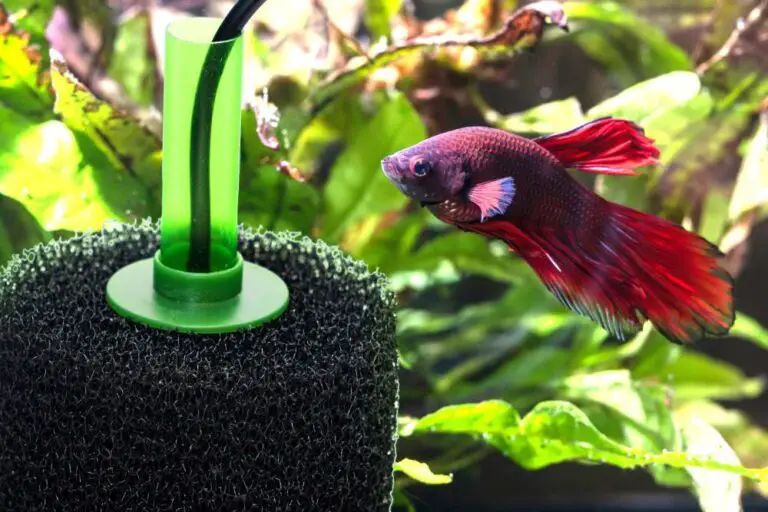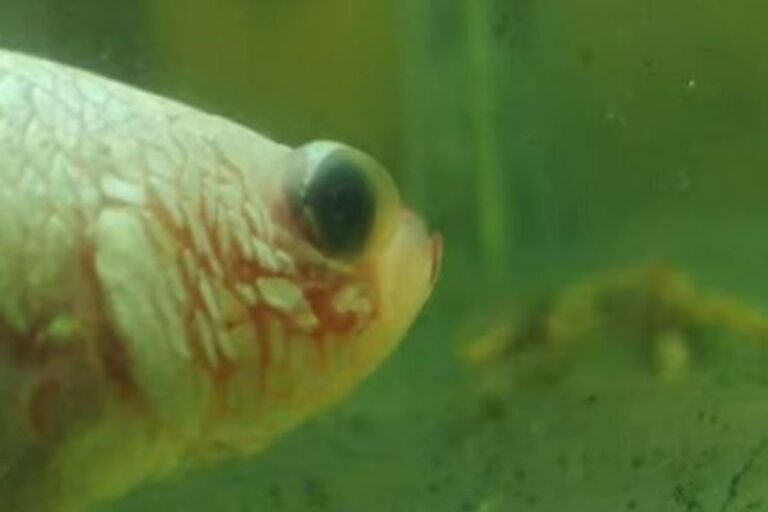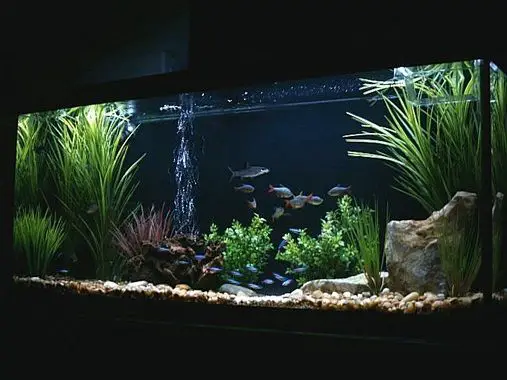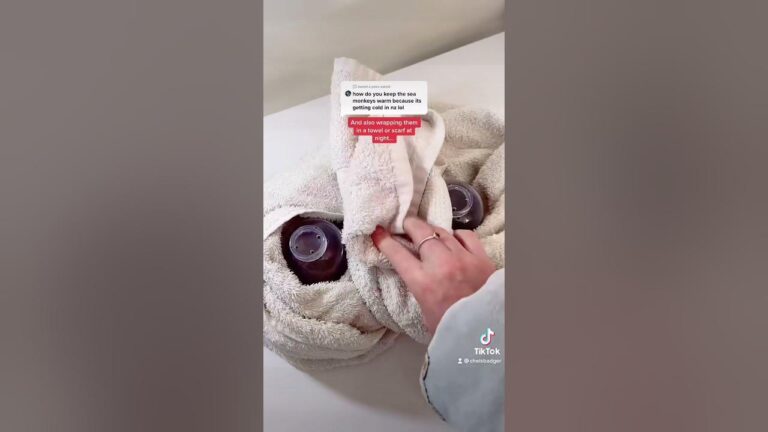How to Move Sea Monkeys to a Bigger Tank?
To move Sea Monkeys to a bigger tank, first be sure that the new tank is clean and free of any debris. Fill the tank with room temperature water and add Sea Monkey food, conditioner, and special growth powder according to package instructions.
Next transfer some of the old water from the old tank into the new one and use an aquarium net or spoon to carefully scoop up as many Sea Monkeys as possible and place them in their new home. Make sure all existing plants are transferred as well.
Finally leave plenty of air space between the top of your water level and rim of your aquarium for oxygen exchange before you close it up.
This will help maintain healthy conditions for your swimming friends!
- Gather supplies: Get a new tank that is large enough to house your sea monkeys, aquarium gravel or sand, a water conditioner and a source of air bubbles such as an air pump and airstone
- Prepare the new tank: Fill the new tank with dechlorinated water up to about three quarters full, then add the aquarium gravel or sand at the bottom and any decorative items you may want in it. Connect the air bubble source to create oxygen for your sea monkeys
- Move Sea Monkeys: Carefully scoop out your sea monkeys from their current home using a plastic cup or something similar, making sure not to disturb them too much in order not to stress them out as they are quite delicate creatures. Place them gently into their new home, being careful not to drop any of them on each other or onto sharp objects like rocks which can hurt their fragile bodies!
- Add food and monitor progress: Feed your sea monkeys according to instructions provided by manufacturer if necessary usually once every two days per package instructions should be sufficient but always read instructions before feeding just in case! Monitor progress over time; make sure that all is going well with both old and young members of colony so everyone can adjust happily into their bigger environment!
Sea Monkey Tank Size
Sea monkeys are a type of brine shrimp that can be kept as novelty aquarium pets. They are sold as eggs that hatch when added to water.
Sea monkeys can live in small tanks, but they need enough space to swim and grow.
A good tank size for sea monkeys is at least 10 gallons, but 20 gallons is better.
The tank should be made of glass or plastic and have a lid to prevent evaporation.
Sea monkeys also need a water purifier, food, and a heater to maintain the optimal temperature of 75-81°F.
Can You Put Sea-Monkeys in a Larger Tank?
Yes, you can put Sea-Monkeys in a larger tank. In fact, it is actually recommended that you keep your Sea-Monkeys in a larger tank to give them enough room to move around and grow.
A good size for the tank would be at least 10 gallons as this will provide ample space for the Sea-Monkeys to swim.
Make sure to include plenty of rocks and plants so they have something to hide behind and explore.
Also make sure there are no sharp edges or anything else that could harm your little friends!
When it comes time to feed your Sea-Monkeys, remember that only a few flakes should be added each day – overfeeding can cause problems with water quality in their new home.
Finally, keep an eye on their behavior as this will tell you if they are adjusting well or not – if all seems normal then congratulations, you have successfully moved your sea monkeys into a bigger home!
Can You Make Sea-Monkeys Bigger?
Yes, it is possible to make Sea-Monkeys bigger! By feeding them a special food supplement called “Grow-A-Fins”, you can encourage your Sea-Monkeys to grow up to twice their normal size.
The Grow-A-Fins food supplement contains a blend of proteins and vitamins that helps stimulate the growth of your Sea Monkeys.
To use this product, simply add a few drops directly into the water every other day for two weeks or until your pet shrimp reach their desired size.
It’s important to keep in mind that overfeeding or over stimulating can cause health issues with these little creatures so be sure not to go overboard when adding the supplement!
It’s best practice to change out at least 10% of the tank water each week in order for the environment to remain healthy and balanced for your growing sea monkeys.
How Do You Change a Sea Monkey Tank?
Changing a sea monkey tank includes several steps and should be done to keep the water fresh and clean for your sea monkeys.
First, remove any old food or debris from the bottom of the tank using tweezers or a small aquarium net.
Then, empty out all of the dirty water in the tank by carefully transferring it into another container with a siphon tube attached to one end.
Refill the tank with fresh dechlorinated tap water that is within 5 degrees of room temperature (68-73°F).
Next, add an appropriate amount of Sea Monkey growth solution as per instructions on package; this will provide nutrients for your pet’s growth and health.
Finally, replace half of the new water every two weeks to ensure proper oxygen levels are maintained in order to promote healthy development in your Sea Monkeys.
Why Are My Sea Monkeys Swimming at the Bottom?
If you notice your sea monkeys swimming at the bottom of the tank, don’t worry. They are not sick or unhappy.
They are probably feeding on the sediment that accumulates over time, which contains food, algae, waste and un-hatched eggs.
This is a natural part of their life cycle and they seem to enjoy it. Sea monkeys also swim up and down depending on the light and temperature.
They may go to the surface at night to eat algae and avoid predators, and sink to the depths during the day to rest and stay cool.
How Long Does It Take Sea-Monkeys to Grow Full Size?
Sea-Monkeys are a unique form of brine shrimp that have been sold as novelty pets since the 1950s. While these little swimmers may look like tiny critters, they can actually grow to full size in just a few weeks.
Once placed in water, it takes about three days for them to hatch out of their eggs and become active.
After this point, Sea-Monkeys will continue to grow and develop over the course of several weeks until they reach their maximum adult size.
Generally speaking, most Sea-Monkey species can reach their full size within six to eight weeks from hatching provided that they’re given proper care during this time frame.
This includes keeping their tank clean with regular water changes and feeding them high quality food designed specifically for these creatures.
With the right conditions, your Sea-Monkeys should be able to reach their full size before you know it!

Credit: www.wikihow.com
How to Clean Sea Monkey Tank?
Cleaning a sea monkey tank is fairly simple and easy to do. To begin, you should remove the sea monkeys from the tank using a net or cup.
Then, fill the tank with warm water and add one teaspoon of dechlorinated tap water per gallon of fresh water used in the tank.
Next, use an aquarium-safe cleaner like vinegar to scrub down any algae that may be on the walls or substrate of your sea monkey’s habitat.
Finally, rinse off all surfaces with clean freshwater before returning your sea monkeys back to their home.
Best Tank for Sea Monkeys
When it comes to choosing the best tank for Sea Monkeys, you should look for one that is made of clear plastic or glass and has a lid to keep them safe.
Make sure the container is large enough to accommodate your Sea Monkey family but not too big so they don’t get lost in all their space. You’ll want to make sure there’s plenty of air circulation without drafts.
Finally, provide some decorations such as rocks or plants with smooth edges so that your Sea Monkeys can have fun and explore their environment!
Large Sea Monkey Tank
A large sea monkey tank is an ideal way to house a larger group of sea monkeys. Sea Monkey tanks come in various sizes, but for best results, it is recommended that you get one at least 20 gallons in size.
This provides plenty of room for the little creatures to swim around and explore their environment.
Since they are saltwater animals they require specific water parameters and regular water changes; having a larger tank makes these tasks much easier!
Sea Monkeys in 1 Gallon Tank
Sea Monkeys are a species of tiny brine shrimp known as Artemia Salina, which can thrive in a 1 gallon tank. While they need plenty of oxygen and food to survive, with the right environment they can live happily in this size space.
A benefit of keeping Sea Monkeys in such a small tank is that it requires less water changes than larger tanks, making them easier to maintain.
Sea Monkeys require minimal equipment for the 1 gallon tank just an air pump and filter system. With proper care and maintenance, these delightful creatures can bring hours of fun!
What Fish Can Live With Sea Monkeys?
Sea Monkeys are a type of brine shrimp, and they can live with certain species of fish such as small tetras, guppies, white cloud mountain minnows and other peaceful community fish.
It is important to note that many larger or predatory fish should not be housed with Sea Monkeys because they may eat them.
How Many Sea Monkeys Come in a Packet?
A typical packet of Sea Monkeys comes with 3 pods, which contain eggs and food to feed the young creatures.
Once hatched, each pod contains around 40-50 individual Sea Monkeys, so a single packet can produce up to 150 lively little critters!
Aqua Dragons
Aqua Dragons are live aquatic creatures that make a great pet for anyone, from kids to adults. They come in their own aquarium kit complete with all the necessary supplies, including eggs and food.
These little animals are easy to take care of and require minimal maintenance, making them an ideal pet for those who don’t have the time or ability to care for more traditional pets.
Aqua Dragons can grow up to 2 cm long and they love to eat shrimp pellets and green water algae!
Conclusion
For those who have already purchased the Sea Monkeys, you now know how to move them from their small tank into a larger one.
Moving Sea Monkeys can be done without any hassle and doesn’t take much time.
The steps outlined in this article should help guide you through the process of safely transferring your Sea Monkeys to their new home.
With these simple instructions, you will soon have happy and healthy Sea Monkeys living in a bigger tank!





